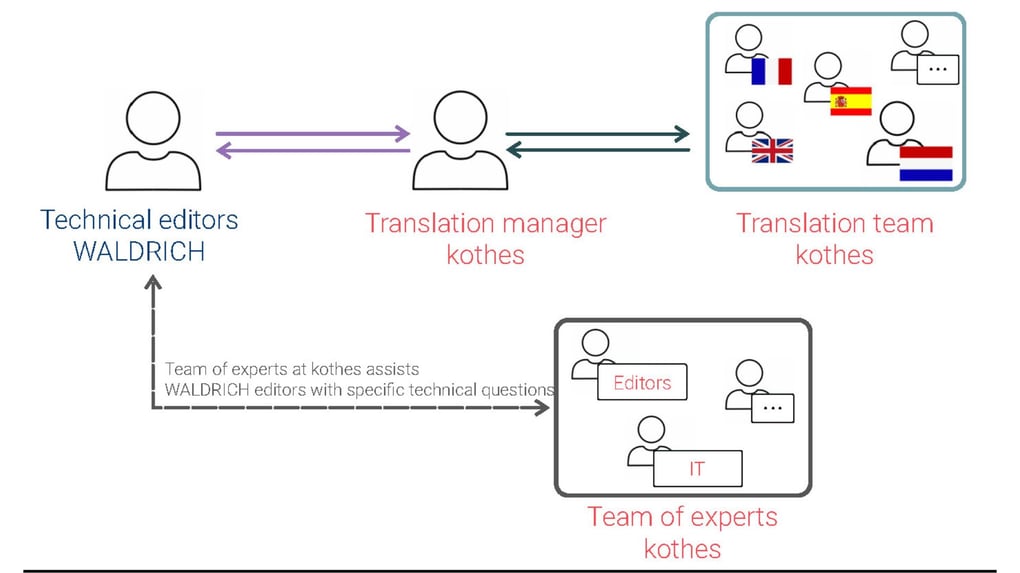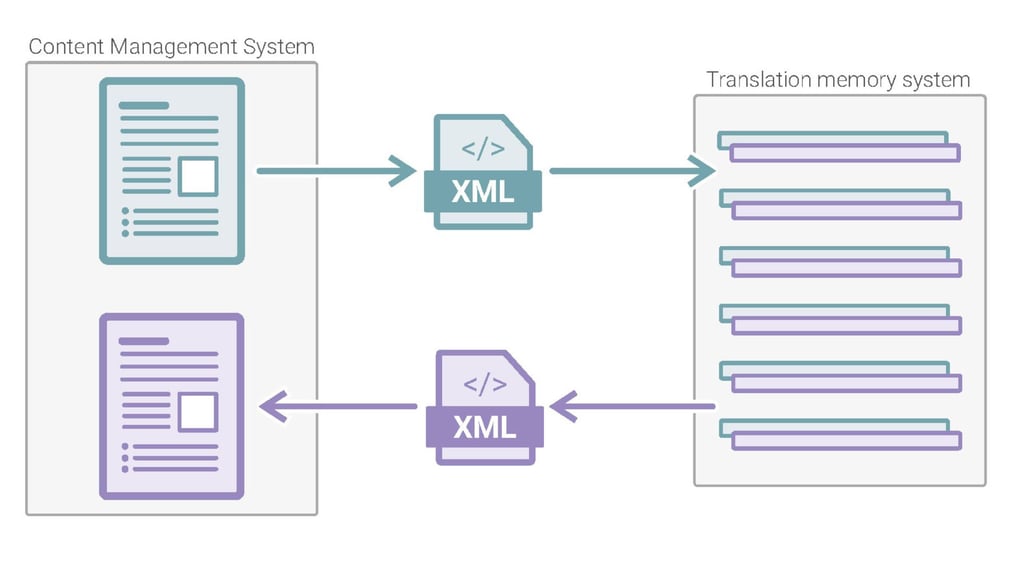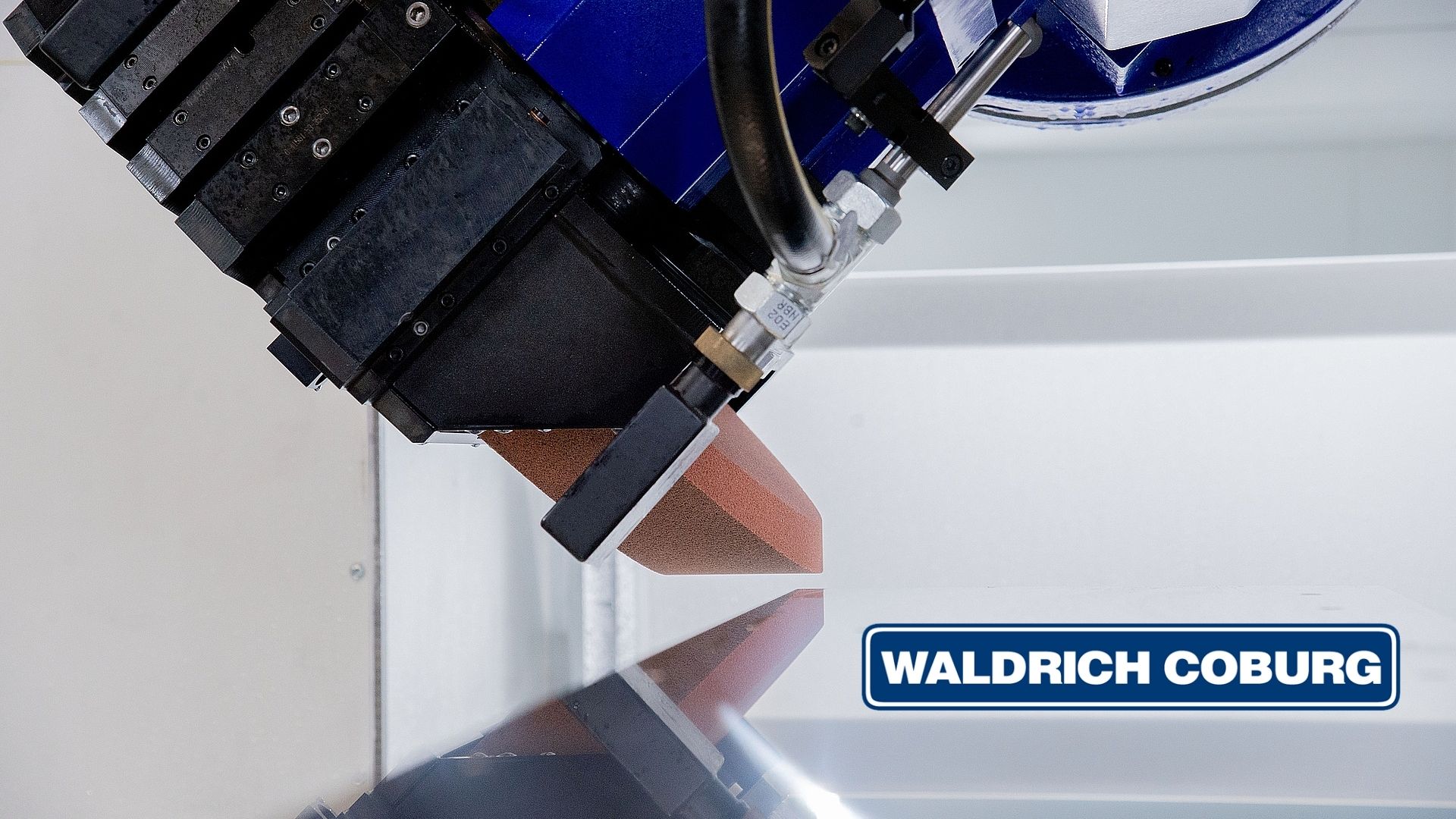From Coburg to the entire world:
In the production halls of its main plant in Upper Franconia (Germany), WALDRICH COBURG GmbH manufactures high-precision large machine tools for use in a wide range of industries, serving customers all over the world with outstanding technology. Thanks to several international locations, there's also a worldwide manufacturing and service network. It's obvious that a global player like WALDRICH pays special attention to the subject of translation.
In very concrete terms, this means that user information such as operating, maintenance, or programming instructions for a machine must be translated into many different target languages – professionally, without mistakes, and on schedule.
Since 2019, kothes has taken on this task and thereby supports WALDRICH COBURG GmbH on its way to many international target markets.
Find out in our field report how we execute this and exactly how WALDRICH benefits from this collaboration.
A look at the initial situation – Why did WALDRICH need translation support?
Not an ideal scenario – this is how you could have summed up the "current state" in the translation process at WALDRICH before we started working together.
One of the main reasons was that the technical workflow with the translation service provider at the time didn't always run smoothly. There was a specific need for optimisation with the exchange of data between WALDRICH's technical editorial department and the service provider: The latter was unable to cleanly process the data packages exported from WALDRICH's CMS – in other words, the source texts to be translated. Accordingly, it was difficult for WALDRICH's technical editors to import the translation data sent by the service provider back into the in-house technical content management system.
A problem that was finally solved in the summer of 2019 with a change of service provider: Since then, we've been taking care of the professional translation of the technical documentation as a new partner, alongside WALDRICH.
How did we get started in working together?
Clear responsibilities – covering short distances
New team, new process, new technologies: Especially at the beginning of a cooperation, both partners first have to get used to each other. In addition to open and trusting communication, clear responsibilities are essential for stable collaboration. That's why it was important for us to provide our new partner with a solid team – right from day one. This creates trust and security on both sides and helps our team to integrate into the customer-specific work processes in the best possible way. How is our WALDRICH team structured?

Translation Manager
To ensure direct communication channels and a direct line to the kothes team, a Translation Manager has been available to WALDRICH from the very beginning. She acts as a permanent contact person for translation projects and deals with all questions and problems relating to the translation process – from the creation of the source-language content to the finished translation. In addition, our Translation Manager coordinates the translation team and clears away both the big and small stumbling blocks.
Support Team
Our support team is intimately familiar with the work processes and technologies found in the field of technical documentation.
If we have very specific questions about technical or editorial aspects, we can quickly and easily call on the expertise of our technical editors and IT specialists. The questions are collected by our Translation Manager and forwarded in a structured manner to the relevant specialist, who then contacts the WALDRICH staff directly. In this way, all the concerns of the WALDRICH team are resolved both quickly and simply.
Translator Team
For each new customer, we build up a team of regular translators, thereby expanding our knowledge of products and target audiences. In concrete terms, this means that WALDRICH has permanent translators for each language combination who are familiar with the company-specific wording and technical terms. This approach minimises content and linguistic coordination efforts and ensures high translation quality over the long term.
Using existing data sources
When a customer changes translation service providers, there's often one central question: What happens to the texts that have been translated and stored over the years?
Of course, the goal should be to ensure that the new service provider can also access this valuable treasure trove of data and use it as a basis for future translation jobs – this saves time and money right from the start of the new cooperation.
For WALDRICH's translation data, we achieved this goal in two steps:
- Import Translation Memory
The Translation Memory (TM) is the digital memory of the translator.
As a Translation Memory, it contains all source texts and the corresponding translations – and is therefore the decisive factor for efficient reuse of previously translated texts.
It was therefore clear to us that we should import the individual Translation Memories from WALDRICH into our translation tool, a so-called Translation Memory System (TMS), right at the start of our collaboration. In this way, we were able to ensure that our translation team – and, in view of the associated cost savings, the WALDRICH technical editorial team as well – would benefit from the translation data that was already available.
How exactly did we go about this? We have a separate TM for each target language, which we integrate into our TMS as a reference. The new translations we create for WALDRICH are now stored in another, new TM. The entries from the existing Translation Memories, which we can reuse for the new translation projects, are first checked by us for linguistic correctness for quality assurance purposes before we import them into our new TM.
- Import Terminology
Saying the right things with the right words: Technical terms and company-specific terms must be translated consistently across all target languages. The key to this is professional terminology management.
Analogous to the integration of the Translation Memory, our goal here was also to import the terminology database provided by the WALDRICH technical editorial team into our TMS right at the start of our collaboration. This means that WALDRICH-specific terminology is automatically used for every translation job, and the translators don't have to go to the trouble of translating the technical terms that already exist in various target languages.
This creates terminological consistency and increases translation quality for the long term.
How does the translation process work?
Clearly defined and lean processes are a decisive factor for translation success. For us at kothes, this means that at the beginning of each new collaboration, we develop a specific procedure that's optimally tailored to the customer's technical and methodological requirements.
How does our translation process for WALDRICH work in practice?
The order e-mail
Which source document is to be translated into which target language? What needs to be taken into account during the translation? The WALDRICH team answers these and other questions before each new translation project in the form of an order e-mail.
This enables an optimal exchange of information between the technical editorial team and the translator, and it ensures that any potential issues can be eliminated in advance.
The data import
The source data to be translated – the heart of the translation process, so to speak – is provided to us by the WALDRICH team in the form of an XML data package. This XML data is then imported into the Translation Memory System by our Translation Manager. This enables us to automatically compare the newly imported text modules with the translations already stored in the TM. The result of this procedure: We receive a detailed matching table that clearly shows the proportion of language pairs that already exist and the extent of the match between these pairs.
This overview serves the kothes and WALDRICH teams as a basis for estimating the cost and effort of the planned translation.
The translation
The actual translation is tool-supported in our Translation Memory System. The TMS breaks down the source text into smaller units, the so-called segments. Each new segment to be translated is automatically compared with all segments already translated in the TMS. If the system finds the same or a similar segment, it offers the translators the translation of the old segment as a suggestion. The translators then decide whether to reuse the entire translation, modify it, or create a new one.
The adapted or newly created segment pairs are immediately stored in the TMS and are in turn available for follow-up jobs at any time.
This procedure increases translation efficiency enormously and also ensures a high level of consistency (and thus high quality) in the various target languages.

The technical translation process at a glance: In the TMS, the source text is translated segment-by-segment.
The quality check
A mistake with numbers or a misspelled word: mistakes happen even to the best translators. This is understandable and doesn't necessarily lead to an incorrect translation – as long as the error is detected and corrected in time. That's why we double-check the translation with our QA check (Quality Assurance) – the first time directly after the translation by the translators themselves and then a second time by our Translation Manager. How does this work exactly?
The QA check is a software-supported check that's carried out in our Translation Memory System. The translation is checked against the following criteria, among others:
- Formal criteria
- Matching of figures in both source and target text
- Consistency of terminology
- Unused entries in the terminology database
- Spelling
The data export
The result of the translation process – i.e. the text translated into the respective target language – is sent back to the WALDRICH technical editorial team as an XML data package. The technical editors at WALDRICH can then easily import this XML data into their CMS.
In what ways has Waldrich benefited most from our collaboration?
Changing a translation service provider inevitably brings changes. Does that sound like a lot of work and a lot of initial effort until the new processes are properly in place? It doesn't have to be – with the right strategy. From our point of view, four aspects were crucial in order to be able to optimise WALDRICH's translation process in both a targeted and sustainable manner.
Intensive support and advice
Our promise from day one: We stand by the WALDRICH team as a reliable partner in all matters relating to translation – whether critical delivery deadlines, editorial questions, or technical problems are involved.
That's why all our projects are managed and handled by a permanent Project Manager.
Technical know-how and tool expertise
The use of modern translation technology reduces expenses and ensures quality. Our goal is to use technology in all translations in such a way that we achieve maximum efficiency and process reliability for WALDRICH technical editorial staff.
This also means that we have the technical know-how and interface expertise to process and export the source and target data without issue.
Translation with technical editorial competence
High-quality target texts require translation-friendly content creation.
As a full-service provider of technical documentation and innovative information solutions, we're well aware of this – and therefore know the many challenges that are part of the daily routine of a technical editor.
Based on this understanding, we also support the WALDRICH team with our technical editorial know-how and expertise.
Our promise is: We use the information bridge between our technical editorial and translation teams to solve questions and problems already in the documentation creation phase and thus increase the efficiency of the downstream translation. It doesn't matter whether we're dealing with specific technical questions about working in the CMS or whether there's a fundamental need for advice on translation-oriented content authoring.
The highest translation quality
Translating is far more than just mastering a foreign language: When selecting our translators, we always pay attention to the so-called "native speaker principle". This means that our translators only ever translate into their native language and not into a foreign language. This is because only in their native language do they have the linguistic feeling that's needed to translate demanding technical content in a comprehensible way.
Our translators also receive regular training on the efficient use of translation technologies, our quality requirements, and process optimisation.
Our conclusion: Achieving the goal better together
- Tight deadlines
- Technical challenges
- Only very limited opportunities to check the quality of the delivered product – i.e. the correctness of the translated text – within your own department
For industrial companies, language services present more than just the above-mentioned challenges. It's understandable that cooperation with a translation service provider requires a degree of trust that shouldn't be underestimated.
We're convinced that through our cooperation with the WALDRICH team, we've been able to successfully build this trust over the past several years.

